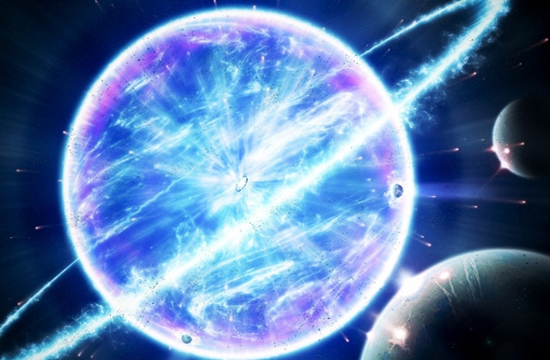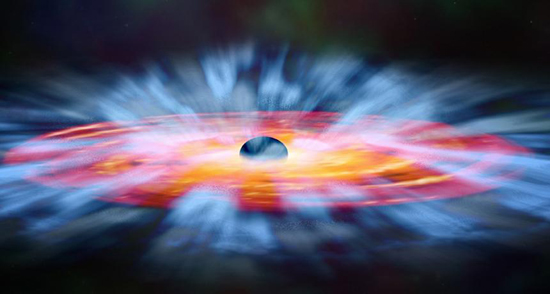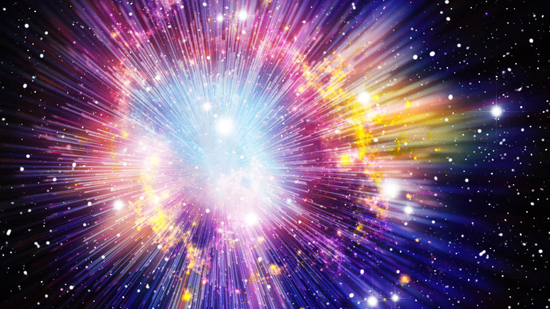The Next Big Bang: Human Consciousness & the Universe’s Ultimate Secret (1)
“The stream of human knowledge is heading toward a non-physical reality. The universe begins to look more like a great thought than a great machine.” Sir James Jeans
For at least two hundred years science has been telling us that any ideas of spirituality we might hold dear are little more than ignorant leftovers of a superstitious past – foolish relics. But the truth is, physics itself, that most foundational of all sciences, has now progressed far beyond that initial, dismissive assessment, to a conceptual worldview far more accepting of spirituality than ever before. To grasp the nuts and bolts of this new science, then, is to understand the nuts and bolts that support a new, evolving and far more sophisticated grasp of spirit than has ever before been available to us.

This new conceptual framework is absolutely critical to our grasp of spirit, and, frankly, for those previously unfamiliar with the discoveries of modern physics, this new framework may at first seem nothing short of “other worldly” itself – as the old saying goes, the truth can at times be far stranger than fiction. So let’s start by taking a close look at what the new physics has to tell us.
In 1964, the scientific world was literally turned on its head by a new theorem, but very few at the time understood just what had taken place. Indeed, so astounding were the material, philosophical, and spiritual implications of this assertion that it would soon be referred to as “the most profound discovery in science.” Yet even today, few beyond a small community of physicists have come to grips with its meaning. The conceptual implications for particle physics were so extreme that for decades after its announcement many within the scientific community resisted its implications, as do some resist them to this day.
The theoretical contentions offered in 1964 have been confirmed and replicated in laboratories across the globe on numerous occasions, and today there is no question that the original assertion was correct. This monumental insight is called Bell’s theorem, and the sea change it caused in physics is still being digested. So central is Bell’s theorem to our understanding of the physical universe, how it functions, and what that means for us as human beings, that to grasp its implications is crucial for anyone interested in the science that today enables us to envision universal processes as far more than simply material phenomena. Yet, simultaneously, to truly grasp the new reality Bell’s theorem implies, it is essential that we first understand the old reality it so violently overturned.
Today many within the scientific community believe that our modern science – that is, the science of observation and testing, of the scientific method – was inaugurated in the seventeenth century when Galileo Galilei first pointed his homemade telescope toward the heavens and started poking around. How did this new science differ from previous approaches to the study of physical phenomena?
Dr. Dean Radin, Laboratory Director at the Institute of Noetic Sciences in Petaluma, California explains:
“Classical physics began in the seventeenth century when pioneers such as Italian mathematician Galileo Galilei, French philosopher Rene Decartes, German astronomer Johannes Kepler, and English mathematician (and alchemist) Isaac Newton advanced a new idea. The idea was that through experiments one could learn about Nature, and with mathematics, describe and predict it. Thus, rational empiricism was born. Classical physics was extended and substantially refined in the nineteenth and twentieth centuries by luminaries like James Clerk Maxwell, Albert Einstein, and hundreds of other scientists.”
This physics – called classical, or Newtonian, or material physics – has made an enormous contribution to our understanding of the universe we inhabit, and as a result has had a profoundly positive effect upon the overall human condition. Food production, health services, economics, education, transportation, etc., etc., have all been vastly improved as a result of scientific applications made available through analysis and testing. No doubt, material science has been a boon to human kind.
Initially, this new science looked outward as had Galileo toward the planets and stars for answers regarding how the universe worked and the matter by which it was constructed. Larger and better telescopes were developed in order to augment this process, and today, of course, spacecraft have been constructed that fly to points distant enough to inspect and photograph distant terrestrial bodies. As a result, a great deal has been learned.
In the eighteenth and nineteenth centuries enormous strides were made in terms of our understanding, not only of the greater cosmos, but also of the physics by which it functions. Most of the planets, their orbits, and their relationship with the sun were established early on. The mathematical calculations for all of this fit nicely within the prevailing understanding, or model, of the universe, and all of these findings both confirmed and augmented our grasp of Newtonian physics.
The Emergence of Quantum Physics
Still, despite all the advances, there were some oddities that did not quite fit. In 1801, for instance, British physicist Thomas Young conducted a “double-slit” experiment in an attempt to deduce the true nature of light. Prior to that, it was assumed that light was composed of small particles of matter, but the result of Young’s experiment seemed clearly to indicate that light was in fact a wave. It was presumed, as a consequence, that light waves would require some sort of medium in order to propagate (conceptualised as a luminiferous ether or ether “wind”), and the search for this medium was promptly initiated. Physics soldiered on essentially unruffled by all of this, however, still confident in its overall grasp of the universe. But this subtle medium, despite numerous attempts at detection, remained elusive.

As a result, light continued to be a thorn in the side of Newtonian physics, thus it was naturally toward the study of light that much attention became focused. In 1900, for instance, American physicist Max Planck developed a mathematical model that demonstrated that light appeared to exist as distinct bursts or “packets” of matter. Planck named these packets “quanta” after the Latin quantus, which translates as essentially “how much.” Planck’s discovery proved the birth of what we today call quantum physics – that is, the study of that group of infinitely small particles that ultimately comprise all matter. Then, in 1905, Albert Einstein, an unknown physicist at the time working as a patent clerk in Switzerland, clearly demonstrated the validity of Plank’s quanta, but it was a proof that also allowed that light had to have both wave and particle characteristics – a perplexing side issue.
Quantum understanding snowballed rapidly. Dean Radin tells us that, “Danish physicist Niels Bohr showed how the quantum concept could explain the structure of the atom (1922 Nobel Prize). In 1924, Louis de Broglie proposed that matter also has wavelike properties (1929 Nobel Prize). In 1926, Erwin Schrodinger developed a wave-equation formulation of quantum theory (1933 Nobel Prize).” Our insight into quantum mechanics was accelerating rapidly, but, despite all the progress, the seemingly dual nature of light remained a vexing problem. Was light comprised of particles or waves? No one could say.
The Big Bang Theory
Meanwhile, additional progress was being made at the observatory by looking in the opposite direction – far out into the depths of the universe. In 1929, as an example, by carefully analysing the red shifts (observed light frequencies) of distant galaxies, American astronomer Edwin Hubble demonstrated that the universe was expanding. An expanding universe was evidence contrary to the Steady State theory of the universe, or a universe that was essentially constant and eternal. Hubble’s finding also suggested that our universe, since it was now seen to be expanding, may naturally have had a beginning; that is, a moment when all that matter had been consolidated in a single point before it started to expand.
Over time this “beginning” became conceptualised as what we today call the Big Bang theory of the universe, or a moment when the material universe emerged from a background of utter nothingness in an enormous burst of heat, light, and matter. The name actually came from British astronomer Fred Hoyle, who quipped one day on British radio that the theory sounded like little more than a “Big Bang,” and while this was stated in jest, the term stuck, nevertheless. The Big Bang theory postulates that the universe emerged from a “singularity” (a point of infinite density, which remains, frankly, beyond our current physics to explain or, as humourist Terry Pratchett once quipped, “In the beginning there was nothing, which exploded”) some 13.8 billion years ago as an incredibly small and incredibly hot point of matter.
According to the theory, this material then inflated, expanded then cooled over time allowing for the formation of light elements like hydrogen and helium. Due to a slightly uneven distribution of matter throughout the universe, gravitational attraction then began to consolidate these elements into clouds which over eons formed the stars, planets and galaxies that comprise the celestial panorama we observe today in our night time sky.
Evidence supporting the Big Bang theory of creation then began to accumulate. This evidence included the original “red shift” Hubble discovered, the discovery of cosmic microwave background radiation (which had been predicted as a residual product from the heat of the initial inflation), and more recent red shift observations of distant supernovae indicating that the expansion of the universe is actually accelerating (and which suggest the existence of dark matter in substantial quantities as the driving force behind this acceleration).
This explanation of the Big Bang is, to say the least, a very brief and general summary of a vast and complex event, but it serves our purposes by bringing us forward conceptually to the year 1964, and the model of the universe that was prevalent at the time Bell’s Theorem made its shocking appearance (minus the dark matter, which was theorised later).

The truth of the matter is, however, while the Big Bang theory provided the universe with both a beginning and a direction, it did not alter the assumption that the universe was fundamentally a material phenomena; a belief central to modern science ever since Galileo had peered through his telescope. History tells us, as an example, that when asked by Napoleon Bonaparte in the early years of the nineteenth century as to why his most recent treatise did not mention the existence of God, the great French scientist Pierre-Simon Laplace was said to have remarked, “I had no need of that hypothesis.” Later, and likewise, Laplace explained to an admiring audience that, “We may regard the present state of the universe as the affect of its past, and the cause of the future.”
In other words, Laplace, along with almost all other scientists at the time, believed that the universe was little more than a vast, material machine, driven by physical forces, and nothing more. If, for instance, you could determine the position and direction of every particle in the universe at any given point in time, it would be possible, at least theoretically, to crank that picture forward or backward, observing as you did every event that had taken place in the past while accurately predicting every event that would take place in the future. This view therefore supported the notion of a deterministic universe, and a universe that was devoid of either free will or human consciousness as a result.
Importantly, this understanding, or model, of the universe rested on certain suppositions that were accepted as true and universal by material physics down through the years simply because the universe appeared to function in accordance with them. The Big Bang was conceptualized as the beginning of an entirely material process that had evolved over eons in accordance with the known parameters of Newtonian (or classical, reductionist, or material) physics. In that sense, the universe was still perceived essentially as a vast, physical mechanism, a machine that was now understood to be a bit more complex than it had been conceived during the earlier days of, say, Pierre-Simon Laplace one hundred and fifty years before, but differing now only in terms of its sophistication, not its fundamental nature. Thus Laplace’s statements regarding the absence of God and the predictive power of the original conditions still held true as far as modern physics was concerned.
The universe was also considered to be a true, functioning reality, and a reality that, having been put in motion by a natural (although inexplicable) occurrence, remained utterly deterministic, events formed and driven forward in time, no longer by the unseen hand of God, but by random particle collisions alone. All events occurred due only to the action of physical forces in contact or proximity with one another, and no force, field, or matter could – according to Einstein’s calculations – ever travel faster than the speed of light. But the wave/particle nature of light still remained an intellectual conundrum that, much like one rotten apple, threatened to subvert the entire structure of physics if not sensibly accounted for.
Read the second part of the article
yogaesoteric
May 20, 2019
